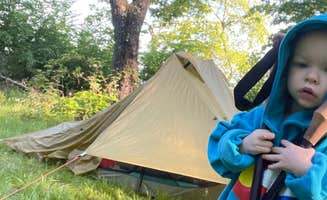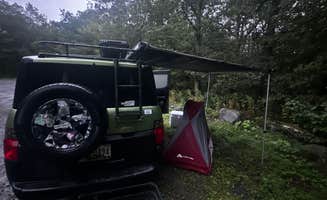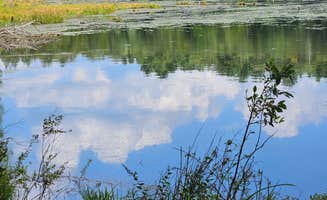Dispersed camping opportunities near Lake Harmony, Pennsylvania extend beyond the Appalachian Trail corridor into several remote trailheads and forest access points. These primitive sites typically require permits from local ranger districts and follow strict regulations regarding overnight stays. Most locations sit at elevations between 1,200-1,800 feet and experience temperature variations that can drop significantly at night, even during summer months when daytime highs average 75-85°F.
What to do
Hiking from trailheads: Thunder Swamp Trailhead serves as both overnight parking and access point to extensive trail networks. "Trailhead parking was chill for a night. No trouble. Tons of hiking. Went down Saw Creek trail to a marsh," reports Jason R. about the Thunder Swamp Trailhead.
Hammock camping: Several dispersed sites offer better options for hammock than tent camping due to terrain challenges. "I was in a hammock and it was a great place for that! The site itself is unmarked when you come to it, but it's the only pretty obvious camping spot on the trail so it's not hard to find," notes Renee Z. about the Appalachian Trail- Designated Backpacker Campsite 2.
Overnight parking: Some trailhead lots permit overnight stays for self-contained vehicles. "It's a gravel parking lot. Plenty of shade. No one bothered me," explains Benjamin H. about his vehicle-based camping experience.
What campers like
Secluded spots: Many sites offer privacy despite their designated status. "We camped nearer to others but there are secluded spots too. Well maintained with bear boxes provided. Good trees for hammocking," writes Katharine T.
Rocky overlooks: Short hikes from parking areas reward campers with scenic views. "The hike to the overlook is really lovely; short and rocky," shares Dani T. about Bake Oven Knob, where visitors can also overnight in vehicles at the trailhead lot.
Bear protection: Some sites provide secure storage for food. "Well maintained with bear boxes provided," notes Katharine T., highlighting an important safety feature at designated backpacker sites.
What you should know
Water availability: Water sources are limited or nonexistent at most sites. "I gave the site only four stars because there's no water nearby. Stock up on water at the Dunnfield creek natural area, or wait until Sunfish pond," advises Renee Z.
Road conditions: Access roads to many sites require high-clearance vehicles. "The road is very rough with huge potholes so good clearance is a must," warns Corey about Hickok Brook camping area, which sits within driving distance of Lake Harmony.
Permit requirements: Camping on state land typically requires permits. "Need a permit on NY state land. Contact Rangers office of whatever county," explains Gregg T., highlighting regulations that apply to most primitive camping in the region.
Tips for camping with families
Limited facilities: Most sites lack standard amenities, requiring thorough preparation. "Bring everything with you. It's a hike back to town... there is a small town 10 minutes away. Eldred, NY," notes Gregg T. about the Hickok Brook area.
Space constraints: Some sites offer limited flat areas for tents. "The site is a little on the small and sloped side for tent camping," mentions Renee Z., indicating that families should prepare for potentially challenging terrain.
Bear safety: Families should follow proper food storage protocols. "Well maintained with bear boxes provided," reports Katharine T. about the Appalachian Trail- Designated Backpacker Campsite 2, though not all sites offer this protection.
Tips from RVers
Limited vehicle access: Most primitive sites are not suitable for recreational vehicles. "I drove in thinking that there would be flat places to park a very rugged camper in my full ton diesel pickup. It's not a good spot for car camping but you could conceivably drive up to the spots and pull off the road," advises Corey about limitations at Hickok Brook.
Overnight parking options: Some trailhead parking areas accommodate self-contained vans. "I've overnighted in my van here a bunch, no problems. There are two large lots. You can park and sleep, or hike in and find a place for a tent," shares Dani T.
Space limitations: RVers should expect minimal designated parking areas. "There are only 3 spots where we are. No motor vehicles beyond where I'm camping," explains Gregg T. about the limited access for vehicles at some primitive sites.




